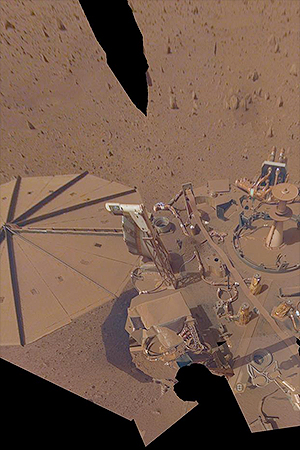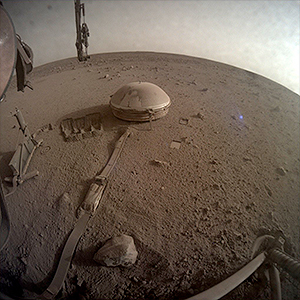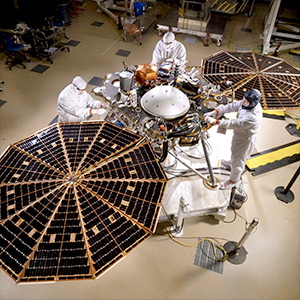December 21, 2022 — A robotic probe sent to study the interior of Mars has met its end after more than four years collecting data on the surface of the Red Planet.
NASA declared its InSight mission over on Wednesday (Dec. 21), six days after the lander ceased responding to communications from Earth. Mission controllers at the agency's Jet Propulsion Laboratory (JPL) in Southern California were unable to contact the three-legged probe after two consecutive attempts, leading them to conclude that its solar-powered batteries had run out of energy — a state engineers refer to as a "dead bus."
NASA plans to continue to listen for a signal from the lander, but hearing from it at this point is considered unlikely. The last time InSight made contact was Dec. 15.
"My power's really low, so this may be the last image I can send," the probe, or rather its managers taking on its persona, wrote in a post on Twitter. "Don't worry about me though: my time here has been both productive and serene. If I can keep talking to my mission team, I will — but I'll be signing off here soon. Thanks for staying with me."
InSight, which is an acronym for Interior Exploration using Seismic Investigations, Geodesy and Heat Transport, collected data about Mars' interior layers, as well as the strong remnants beneath the surface of its extinct magnetic dynamo, weather at its landing site and "marsquake" activity.
"I watched the launch and landing of this mission, and while saying goodbye to a spacecraft is always sad, the fascinating science InSight conducted is cause for celebration," Thomas Zurbuchen, NASA's outgoing associate administrator for science, said in a statement. "The seismic data alone from this Discovery Program mission offers tremendous insights not just into Mars but other rocky bodies, including Earth."
Since InSight touched down at Mars' Elysium Planitia on Nov. 26, 2018, scientists at the French space agency CNES (Centre National d'Etudes Spatiales) and ETH Zurich have used the lander's seismometer to detect 1,319 marsquakes, including quakes caused by meteoroid impacts, the largest of which unearthed boulder-size chunks of ice in late 2021. Such events help determine the age of the planet's surface and data from the seismometer provides a way to study the planet's crust, mantle and core.
"With InSight, seismology was the focus of a mission beyond Earth for the first time since the Apollo missions, when astronauts brought seismometers to the moon," said Philippe Lognonné of Institut de Physique du Globe de Paris, principal investigator of InSight's seismometer. "We broke new ground, and our science team can be proud of all that we've learned along the way."
The seismometer was the last science instrument that remained powered on as dust accumulated on InSight's power-providing solar panels, gradually reduced its energy — a process that began before NASA extended the mission earlier this year.
InSight was also equipped with a self-hammering spike, nicknamed "the mole," that was intended to dig 16 feet down (5 meters), trailing a sensor-laden tether that would measure heat within the planet, enabling scientists to calculate how much energy was left over from Mars' formation. Designed for the loose, sandy soil seen on other missions, the mole could not gain traction in the unexpectedly clumpy soil around Insight's landing site.
The instrument, which was provided by the German Aerospace Center (DLR), eventually buried its 16-inch (40-centimeter) probe just slightly below the surface, collecting data on the physical and thermal properties of the Martian soil along the way. This data will be useful for any future human or robotic missions that attempt to dig underground.
The mole was buried to the extent it was possible thanks to engineers using InSight's robotic arm in inventive ways. Primarily intended to set instruments on the Martian surface, the arm and its small scoop also helped remove dust from InSight's solar panels as power began to diminish. Counterintuitively, the mission determined they could sprinkle dirt from the scoop onto the panels during windy days, allowing the falling granules to gently sweep dust off the panels.
Ultimately, though, the dust layer was enough to drop the probe's power supply below its ability to operate. InSight's team had estimated that the mission would end sometime between late October and January 2023, based on predictions of how much the dust on the solar panels would reduce power generation. In total, InSight was active on Mars for 1440 sols (1,480 days or four years and 19 days).
"InSight has more than lived up to its name," said Laurie Leshin, JPL director. "As a scientist who's spent a career studying Mars, it's been a thrill to see what the lander has achieved, thanks to an entire team of people across the globe who helped make this mission a success. Yes, it's sad to say goodbye, but InSight's legacy will live on, informing and inspiring." |
|

The final "selfie" taken by NASA's InSight Mars lander on April 24, 2022, the 1,211th Martian day, or sol, of the mission, revealed the build up of dust on the probe's solar panels. (NASA)

The last image sent back by NASA's InSight Mars lander showing the probe's seisometer deployed on the Martian surface. (NASA)

NASA's InSight lander seen during a solar array deployment test at Lockheed Martin's clean room in January 2018. (Lockheed Martin) |
